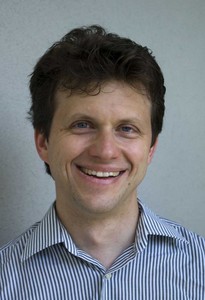


The goal of molecular electronics is the use of molecular structures as active components in electrical circuits. In order to achieve this goal basic questions like the connection between molecules and metallic contacts and the conductance of a metal-molecule contact need to be addressed. Using the mechanically controllable breakjunction technique we have performed transport experiments through single ethyne molecules attached to gold electrodes via thiol, nitro, and cyano anchoring groups. We have measured current-voltage characteristics inside a liquid cell. By fitting the experimental curves to a single-level resonant tunneling model we are able to extract both the position of the molecular orbital closest to the Fermi energy and the strength of the metal-molecule coupling. We compare the results to ab initio calculations which give further insight into the transport properties. The dependence of the I-V characteristics on the various anchoring groups shows clearly that these groups affect the coupling strength between metal and the molecules as well as the position of the molecular energy levels. The breakjunction technique was used to contact single DNA molecules and to characterize the influence of the molecular conformation on the conductance of the junctions. Here we show that sequences which form quadruplex structures can be used as extendable wires. Duplex DNA represents a wire with a fixed length but a comparably large conductance.



The goal of molecular electronics is the use of molecular structures as active components in electrical circuits. In order to achieve this goal basic questions like the connection between molecules and metallic contacts and the conductance of a metal-molecule contact need to be addressed. Using the mechanically controllable breakjunction technique we have performed transport experiments through single ethyne molecules attached to gold electrodes via thiol, nitro, and cyano anchoring groups. We have measured current-voltage characteristics inside a liquid cell. By fitting the experimental curves to a single-level resonant tunneling model we are able to extract both the position of the molecular orbital closest to the Fermi energy and the strength of the metal-molecule coupling. We compare the results to ab initio calculations which give further insight into the transport properties. The dependence of the I-V characteristics on the various anchoring groups shows clearly that these groups affect the coupling strength between metal and the molecules as well as the position of the molecular energy levels. The breakjunction technique was used to contact single DNA molecules and to characterize the influence of the molecular conformation on the conductance of the junctions. Here we show that sequences which form quadruplex structures can be used as extendable wires. Duplex DNA represents a wire with a fixed length but a comparably large conductance.